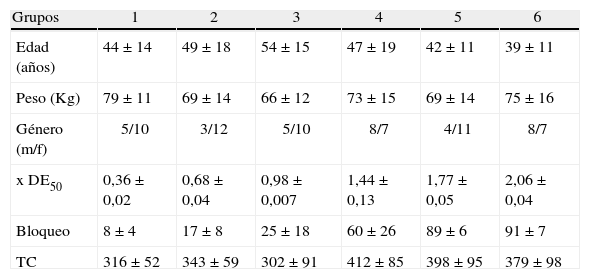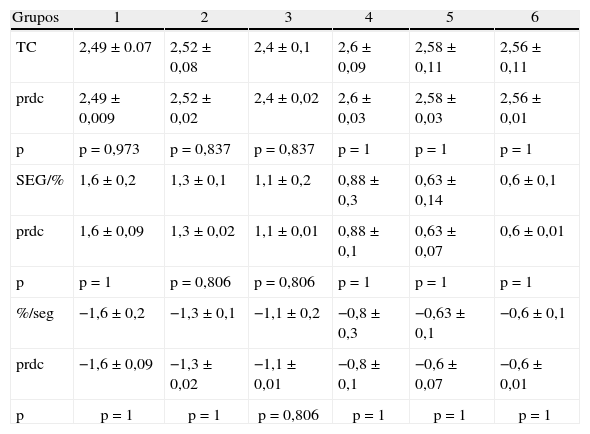Estudiar la correlación entre dosis subparalizantes de atracurio con el comienzo y velocidad.
Material y métodoSeis grupos de pacientes recibieron: 0,36; 0,68; 0,98; 1,44; 1,77; ó 2,06 x DE50 de atracurio. Se determinaron el máximo efecto, tiempo para alcanzarlo (TC), las concentraciones molares (μM.Kg−1) y velocidad de acción (VA) [relación entre tiempo y efecto (seg/%) o viceversa (%/seg))] de cada dosis. Para su correlación se convirtieron en logaritmos o raíz cuadrada. De la línea de regresión se obtuvieron: la fórmula, R2 y significación estadística.
ResultadosLa correlación entre los logaritmos de la μM.Kg−1 y TC fue pobre y no significativa (R2=0,564; p=0,138), pero fue muy alta y significativa con la VA seg/% (R2=0,952; p<0,001) y VA %/seg (R2=0,984; p<0,001). Al resolver las fórmulas de regresión se pudo predecir el comienzo. Cuando los valores se transforman en V2 los resultados fueron similares.
ConclusiónEl TC de un bloqueante neuromuscular está ligado a su efecto y la permeabilidad al tamaño de sus moléculas oμM.Kg–1, la cual a su vez es función de la dosis. En el caso del atracurio, esta correlación resultó pobre y no significativa, hallazgo que coincide con el de otros autores cuando aseguran que el atracurio se aleja de la línea de regresión entre cantidades equipotenciales de varios bloqueantes neuromusculares. En cambio la sustitución de TC por VA permite establecer una buena y significativa correlación. Los resultados sugieren la dependencia entre velocidad del atracurio y el tamaño de su molécula.
To study the correlation between the subparalyzing dose of atracurium and its onset time and speed of action.
Material and methodsSix groups of patients received 0.36, 0.68, 0.98, 1.44, 1.77, or 2.06 times the median effective dose of atracurium. The maximal effect, onset time, molar potency (μM·kg−1) and speed of action (relationship between time in seconds and percentage of maximum effect and between percentage of maximum effect and time) of each dose were measured. The values were converted to logarithms and square roots to test for correlations. The regression line provided the equation, coefficient of determination (R2), and statistical significance.
ResultsThe correlation between the logarithms of molar potency and onset time was poor and not statistically significant (R2=0.564, P=.138), whereas the correlations between the logarithms of molar potency and speed of action (seg/%) (s/maximum % effect, R2=0.952; and maximum % effect/s, R2=0.984) were strong and statistically significant (P<.0001) The regression formulas were able to predict the onset time. The results were similar when the values were converted to their square roots.
ConclusionThe onset time of a neuromuscular blocker is linked to its effect and its permeability is linked to the size of its molecules or the molar potency, which is dose-dependent. In the case of atracurium, this correlation was poor and not significant. This finding coincides with those of other authors, who found that atracurium was distant from the regression line for equipotent quantities of different neuromuscular blockers. Substituting onset time with speed of action, however, made it possible to establish a strong and significant correlation. Our results suggest that the speed of action of atracurium depends on the size of its molecule.
Artículo
Comprando el artículo el PDF del mismo podrá ser descargado
Precio 19,34 €
Comprar ahora











